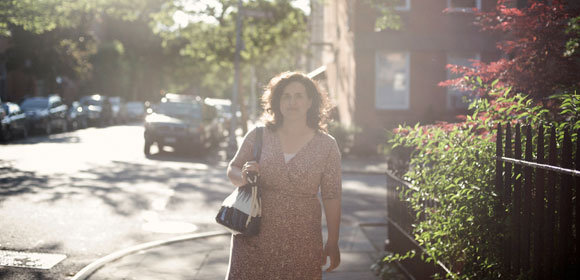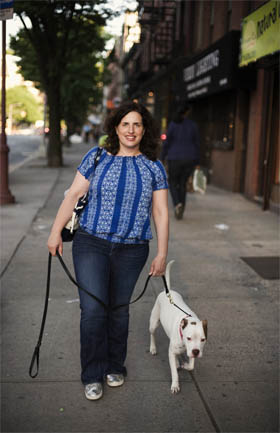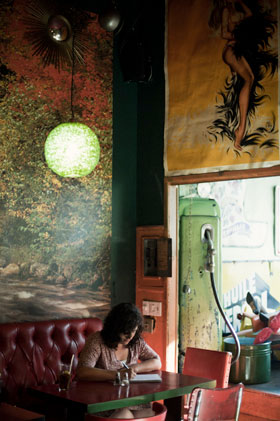
Making It Up As She Goes Along
Return to page 1 | Page 2 of 2
 IN THE LONG-FORM IMPROVISATION technique known as “the Harold”—invented and jokingly named by the actor and teacher Del Close—collaboration is crucial. Following the mantra of “Yes, and…,” performers accept and build on every contribution. Individuals don't try to provoke easy laughs or grab the spotlight for themselves. Instead, players strive as a team to create emotional and intellectual connections, to make each other look good, and to develop a set of interconnected scenes that is greater than the sum of its parts.
IN THE LONG-FORM IMPROVISATION technique known as “the Harold”—invented and jokingly named by the actor and teacher Del Close—collaboration is crucial. Following the mantra of “Yes, and…,” performers accept and build on every contribution. Individuals don't try to provoke easy laughs or grab the spotlight for themselves. Instead, players strive as a team to create emotional and intellectual connections, to make each other look good, and to develop a set of interconnected scenes that is greater than the sum of its parts.
As a writer, Sagher embraces the same ethic of teamwork. “Working on TV is so much more ensemble-oriented than writing alone,” she says. “That's where I think the improv background really helps.” At 30 Rock, both on-screen and off, writers hunker down in a room and figure out story arcs together. Individual writers will outline and initially draft a script on their own, but the group “punches up and rewrites” drafts collectively.
When joined with a strong cast, the “all-hands-on-deck” approach to comedy works—30 Rock won two Emmys, a Peabody, and three Writer's Guild Awards when Sagher was there—but it is exhausting. “Sometimes you'd be there from ten in the morning until seven the next morning,” she says. “We filmed in a place called Silvercup Studios, which used to be a bakery, so there are still mice there. It sucked to be there at four in the morning and see mice run across the room. It was not glamorous.”
Last year, Sagher moved to a writing job with the HBO series Bored to Death, a sitcom about a Brooklyn writer who moonlights as a private eye. Created by comic novelist Jonathan Ames and starring Jason Schwartzman and Ted Danson, “it's a fun show because it straddles film noir and comedy and Brooklyn.” For writers, “it's a pretty dreamy set-up,” Sagher says. There are eight 30-minute episodes in a season rather than the network standard of 22, which means the timeframe for developing material is “really luxurious and lovely.” The culture is collaborative but the writing team—which includes Ames—is smaller. Episodes are shot on location, all over the city. During filming, Sagher and the other writers usually stay on the set, “in case there is a moment that could be tweaked somehow—and also, because it's just cool to be there.”
Working with celebrities, Sagher admits, is “super cool.” Of 30 Rock star and creator Tina Fey, she says, “As smart and funny as you think she is, she's smarter and funnier. Her mind goes a million miles an hour.” Hearing Alec Baldwin read a memorable script was “a thrill”—so was having Steve Buscemi direct one of her episodes. One recent weekend in April, Sagher shared the stage at Upright Citizens Brigade with Amy Poehler, Horatio Sanz, and Seth Meyers, all from Saturday Night Live; Zach Woods from The Office; John Lutz from 30 Rock; and a half-dozen other writers and improvisers. Like Sagher, many launched their careers in Chicago.
 AT A SATURDAY NIGHT SHOW, the 150-seat UCB theater is packed and rowdy. The audience—comedy nerds who have lined up on West 26th Street for $10 tickets—seems just as fired up about witnessing good work as seeing famous faces. Following the suggestions “sad,” “horny,” and “mm-bah,” Sagher and Neil Casey kick things off with a short scene about an unhappy couple shopping for furniture. Two new actors jump in with an argument between a masturbating toll booth operator and his angry boss. That leads to scenes about a middle-school production of Cats, an execution, and an estranged lesbian couple at a baby shower. The hour-long “Harold” produces big laughs and a few serious dramatic moments. It's a wild ride, but it succeeds.
AT A SATURDAY NIGHT SHOW, the 150-seat UCB theater is packed and rowdy. The audience—comedy nerds who have lined up on West 26th Street for $10 tickets—seems just as fired up about witnessing good work as seeing famous faces. Following the suggestions “sad,” “horny,” and “mm-bah,” Sagher and Neil Casey kick things off with a short scene about an unhappy couple shopping for furniture. Two new actors jump in with an argument between a masturbating toll booth operator and his angry boss. That leads to scenes about a middle-school production of Cats, an execution, and an estranged lesbian couple at a baby shower. The hour-long “Harold” produces big laughs and a few serious dramatic moments. It's a wild ride, but it succeeds.
In improv, there are no sets, props, or costumes. Players don't prepare—although most rehearse at least weekly—and at UCB, they don't get paid. “You just show up,” says Sagher, likening the Harold to a pick-up basketball game. “At this point, we've all been doing it for more than ten years.” Onstage she wears the same jeans, clogs, and polka-dot sweatshirt she had on at our interview 90 minutes earlier. Her curly brown hair is pulled back in a pair of drugstore barrettes; no make-up seems to cover her freckles.
Men outnumber women on the team, but Sagher doesn't think there's pressure on female performers to act like one of the guys or that comedy is a man's world. “I came from math,” she laughs, “so I never looked at comedy and said, ‘Oh no, where are all the women?' And when I was coming up, there were all these amazing women like Amy Poehler and Tina Fey and Rachel Dratch on the Mainstage at Second City. So it actually seems pretty balanced.”
IF TELEVISION WRITING PAYS THE BILLS, why bother with improv? That's where Durkheim—and math—come back in. Doing long-form improvisation, “I've seen people be emotionally true and at the same time inventive, while keeping in mind the larger framework of a show. When it works, it's really magical,” says Sagher. “I'm going to horribly mangle what I remember of Durkheim, but he talked about there being a god-presence in groups—that's what they get out of performing these rituals and these totems.”
“I think it's the same for improv,” she continues. “Sometimes, when it all goes well, we're so in sync that it's like a thrill ride.” Unlocking an elegant proof in math used to inspire a similar sensation of “being in the presence of something sacred,” she remembers. “When you get to think really deeply in math, it's like a rush.”
Sagher believes that performing breathes life into her writing, so she expects to continue doing both. In the coming year, she wants to stage one of her L.A. solo shows in New York. Occasionally, she teaches improv classes, and she has a hot idea for a book that she doesn't want to talk about.
Those are her plans, but what is her ambition? “That's a good question,” she says. “I'm still figuring that out.” Like any good improviser, Sagher has learned to stay in the moment and not worry about making mistakes. On stage, she has the skill and experience to know when she should jump into a scene and change its direction. There are also times when she stands back, arms folded, and lets others move the action forward.
When a scene draws big laughs, it might be because Sagher inspired the joke. But just as often, she has stepped to the sidelines and—waiting for her turn, watching someone else succeed—she's wearing the biggest grin in the house.
